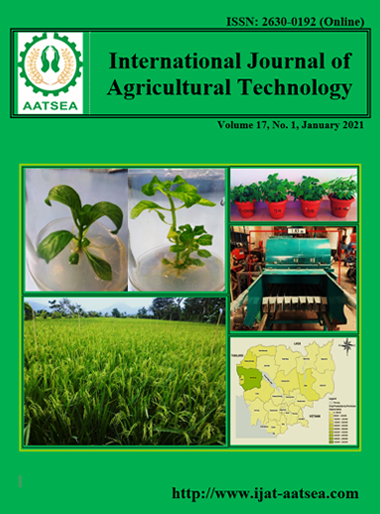Inhibition of xanthine oxidase and uric acid in canned bamboo shoot by Yanang juice
Main Article Content
Abstract
Effects of temperature (30, 80 and 95 °C) and time (5, 10, 15, 20, 25 and 30 min) were studied on xanthine oxidase activity and uric acid content of bamboo shoots in Yanang juice. The ratio of bamboo shoots to Yanang juice was investigated for physical and microbiological properties and uric acid content after subjection to 121 °C at F0 5 min. Results showed that increasing temperatures resulted in decreasing uric acid content. Heating bamboo shoots in Yanang juice resulted in greater reduction of uric acid than heating in water. The inhibitory effect of heating on xanthine oxidase in terms of IC50 value at 95 °C was the highest (57.08%) as its IC50 value was the lowest (74.09 µg/mL), followed by heated samples at 80 °C (82.71 µg/mL) and 30 °C (84.34 µg/mL), respectively. Heating bamboo shoots in Yanang juice at 95 °C for 30 min was selected as the optimal preparation condition before the canning process. Ratios of bamboo shoots to Yanang juice at 1:3, 1:3.5 and 1:4 showed little effect on quality of the canned sample. Hardness of canned bamboo shoots was lower than fresh bamboo shoots. Lower viscosity and darker color of heated bamboo shoot samples were observed in Yanang juice compared to fresh samples. Total bacterial counts and flat sour bacteria were not detected in any of the products. Canned bamboo shoots undergoing high temperatures for a long time to maximize product safety contained uric acid at 4.12-8.82 mg/100 g bamboo shoots. Therefore the practical applications of the step of bamboo shoot preparation in canned processing could be applied to the food industry
Article Details

This work is licensed under a Creative Commons Attribution-NonCommercial-NoDerivatives 4.0 International License.
References
Adams, J. B. (2007). Review: Enzyme inactivation during heat processing of food stuffs. International Journal of Food Science and Technology, 26:1-20.
Aichayawanich, S., Phungamngoen, C., Wongsa, J. and Parametthanuwat, T. (2018). Degradation kinetics of cyanide and uric acid in bamboo shoot during boiling process. Proceedings of ICBBB, 2018 Jan 18-20; Tokyo, Japan.
Awuah, G., Ramaswamy, H. and Economides, A. (2007). Thermal processing and quality: Principles and overview. Chemical Engineering and Processing, 46:584-602.
Cenkowski, S., Pronyk, C., Zmidzinska, D. and Muir, W.E. (2007). Decontamination of food products with superheated steam. Journal of Food Engineering, 83:68-75.
Charoen, R. and Phungamngoen, C. (2016). Product development of canned Thai food by thermal processing. International Food Research Journal, 23:1320-1326.
Dutta, D., Dutta, A., Raychaudhuri, U. and Chakraborty, R. (2006). Rheological characteristics and thermal degradation kinetics of Beta-carotene in Pumpkin puree. Journal of Food Engineering, 76:538-546.
Eadmusik, S., Phungamngoen, C. and Choosuk, N. (2019). Kinetic degradation of total phenolic content, DPPT radical scavenging and xanthine oxidase inhibitory activities in Yanang leaf (Tiliacora triandra) extract during preparation process. Malaysian Journal of Analytical Sciences, 23:516-523.
Halevi, S. (2016). Various food types and their purine content. AcuMedico, Chinese medicine articles. Retrieved from http://www.acumedico.com/purine.htm.
Japan National Standard (2004). Canned ready to eat food. Database of National Food Institute, Bangkok, Thailand.
Phungamngoen, C., Eadmusik, S., Chenin, S. and Aichayawanich, S. (2016). Study of factors affecting stability of Yanang juice in canned bamboo shoot in Yanang juice process. Proceedings of the 9th TSAE International Conference; 2016 Sep 8-10; Bangkok, Thailand.
Pongdee, J. and Gatsorn, N. (2014). Effect of stabilizer on quality of canned bamboo shoot in Yanang juice (Bachelor project). Department of Agro-Industry: King Mongkut’s University of Technology North Bangkok, Thailand.
Potter, N. and Hotchkiss, J. H. (1998). Food Science. 5th ed. Philadelphia: Aspen Publisher Inc.
Promnuchit, P. and Khotmee, P. (2011). Study on uric acid reduction of bamboo shoot (Bachelor project). Khon Kaen University, Thailand.
Satya, S., Bal, L. M., Singhal, P. and Naik, S. N. (2010). Bamboo shoot processing: food quality and safety aspect (a review). Trends Food Science and Technology, 21, 181-189.
Suwankanid, C., Chaungchaichana, V. and Srisupho S. (2006). Production of bamboo shoot and Yanang Juice in suitable packaging (Bachelor project). Suan-Dusit University, Thailand.
Tang, Y., Long, J. and Liu, J. (2014). Hyperglycemia-associated oxidative stress induces autophagy: Involvement of the ROS-ERK/JNK-p53 pathway in Chapter 8, Autophagy: cancer, other pathologies, inflammation, immunity, infection, and aging, Molecular mechanisms, 1:105-115.
Umamaheswari, M., Asokkumar, K. and Sivashanmugam, A. T. (2007). In vitro xanthine oxidase inhibitory activity of the fractions of Erythrina stricta Roxb. Journal of Ethnopharmacology, 124:646-648.
Yiumhan, P. (2010). Determination cyanide content in bamboo shoot by spectrophotometry technique (Master project). Faculty of Science: Khon Kaen University, Thailand.
Zuo, R., Zhou, S., Zuo, Y. and Deng, Y. (2015). Determination of creatinine, uric and ascorbic acid in bovine milk and orange juice by hydrophilic interaction HPLC. Food Chemistry, 182:242-24.


